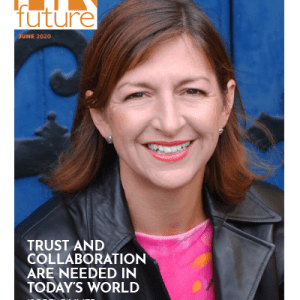Four years ago, Anne Traer left her career in high tech to go low tech. Traer, who spent two decades steadily progressing up the ranks of senior management at companies like PayPal and Oracle, is now an organic farmer and owner of the floral shop Garden and Roads in Medford, Massachusetts.
These days, she spends her work weeks digging up soil, tending her gardens, or arranging flowers in her workshop. As a sole proprietor, she is often on the road dropping off orders at weddings, homes, even office buildings — an environment she does not miss.
In her next-to-last tech post at PayPal, she focused on small- and mid-sized merchant solutions. It was the perfect preparation to help her ask the right questions as she contemplated whether a mid-career pivot from senior-level manager to small business owner made sense for her.
“I asked myself so many questions: Am I a risk-taker? Do I want to take out a loan? Or do I want a [business] partner? Should I build a cushion first?” Traer remembers.
Mid-career hits some women at a time in their lives when a houseful of children means money is top-of-mind. For other working mothers, mid-career can come at a time when full-time employment is not a realistic option because of responsibilities at home. For others still, the mid-point in your professional life might find you childless, making it a necessary time to think strategically about what the next steps in your career might look like.
While every woman at this stage of her career will have different questions, it’s at this stage that they tend to pop up like mushrooms, one after another. Should I work more than ever to make up for the time and income lost while raising my kids? Should I switch careers or start my own business? Do I leave the corporate world for a nonprofit and try to make a difference in the world?
If a woman’s working life is between 35-40 years long, the mid-point will fall somewhere between years 10 and 25. If you are at a midpoint in your career, ask yourself the following questions to ensure that your path forward is clear and well-marked:
1. What is most important to me?
Life coach Diane Lang often makes clients who are evaluating their professional futures start by creating a vision map of images representing career, finances, health, and relationships, with each occupying its ideal place and amount of space.
“I get them to ask themselves, ‘What’s important now?’ Not what was important 20 years ago. What do you care about now?” Lang says.
Lang helps her clients to stop dwelling on doubt and focus on a tangible course of action by asking the right questions about their goal: “What do I need to learn? Do I need new skills? New certifications? Do I have one or two people who will support me unconditionally?”
Like Lang, empowerment coach Marsha Haygood tends to steer her mid-career clients away from smaller questions and fears and toward the bigger picture.
“You need to know your why before you can worry about how,” Haygood says. “Where do you want to live? What do you enjoy? What should success look like for you? Let’s start there. I say, pull your dreams out of storage.”
2. Should I stay the course or pivot?
Melissa Loparco’s mid-career moment came early when she decided to leave a large public relations agency in New York City to take a director role at a much smaller firm in her hometown.
Working at a big agency in the city had been her dream, and here she was contemplating an early exit out of the fast lane. Could she give up her big dream for a smaller one? She also had to decide if she felt seasoned enough to take on a director role. Like Traer, her pivot was preceded by lots of self-questioning.
“Am I able to do this? Will I enjoy it? What value would I be bringing to this new role?” These were just a few of the questions she made herself consider before she took the offer from Catalyst Marketing Communications. Twenty years later, Loparco remains with Catalyst.
“I stayed because it has remained rewarding and challenging and because I continued to feel I was valuable,” she says. “I learned I was smarter than I ever thought I was. I’ve grown professionally, and, as a woman, I’ve had a voice where I work.”
Marsha Haygood says some clients come to her not because they want to leave their employer but because they want to stay and move up the ladder to the management or director level. As one of the few Black women to attain director-level leadership during her years in the entertainment industry, Haygood is uniquely qualified to get her clients where they want to go.
“If you want to stay at your current job, what steps do you need to take now to get to where you want to go?” Haygood says, listing considerations like additional education and certification and finding the money and time that might require. “Are they willing to invest in themselves?”
Haygood also asks them to take stock of their network: “Who do you know? Who do you need to know? And what do they need to know about you?”
3. If a professional pivot is appealing, what is motivating my desire for change?
Lang agrees with Traer that for many women, mid-career is a time of transition and questioning. Many of Lang’s clients seek out her services because they want to pursue a career change, but they’re afraid to say out loud exactly what that new career might be. Instead, they say they want a change but aren’t sure what the next step should be.
So Lang asks: “What is the ‘why’ behind the career change? Why are you leaving? What is the motivation to move on to the new thing?” Only then does Lang ask the big question: “If you cultivated your dream career, what would it look like?”
Lang notes that the “mid-career feeling” comes for different women at different ages. Some women focus on making as much money as possible before retirement.
“Now, it’s less about retirement and more about positive aging,” Lang says. She says fewer middle-class college-educated clients are concerned about retirement because they don’t plan to retire.
In addition, over the past two decades, young college graduates have been motivated by student loans to focus on making as much money as possible early in their careers, Lang says.
A couple of decades into their careers, Lang says, “They suddenly realize that what I wanted to do in my 20s doesn’t fit my values or doesn’t interest me anymore. Money is not as pressing a motivator, and they aren’t as interested in status, power or proving themselves to others as they were at the start of their careers.”
4. If my professional goals involve money, how much do I need?
There are segments of Lang’s New York suburban clientele focused solely on commanding a higher salary during the second half of their working lives. For example, former teachers who retire once they have earned their full pension often come to Lang wondering if there is a field they can now enter or a business they can start that will make them enough to augment their retirement. Other women come to her after a divorce needing to find a way to support themselves.
She starts by making these women figure out how much they need to earn by listing expenses and assessing their investments and debts. She works with them to map out a plan based on reasonable salary and benefits requirements. But even women looking for a path that will allow them to earn more money say that they have to enjoy what they do.
“Liking what you do in your work life is more important for women than men,” Lang says. “Women will take a small income cut to have more balance, or to help others or to be part of a mission-driven organization.”
5. How much am I willing to risk?
By mid-career, many women’s expenses are decreasing. Their children move out of the house or finish school; even their homes are nearly paid off.
“Women in their 40s, 50, and 60s are way more willing to take risks,” Lang says.
Nevertheless, shifting gears to a lower-paying mission-driven role might come with significantly less income. Perhaps their career move will require relocation to a cheaper area of the country. When Haygood’s clients lose hope due to financial obstacles, she helps them see where they can cut back and do without.
“There are certain things that you can do that can help,” Haygood tells her clients. For example, she suggests, “What would happen if you stopped shopping for new clothes for a year?”
Haywood knows it can be done because 15 years ago, before starting her leadership training and empowerment company, StepWise, she did it herself.
“I stopped shopping for the year before I started StepWise.” Instead, she says, “I went shopping in my closet. I’d find stuff I forgot I had.”
6. When is the right time to put your plan into action?
Once a plan is in place, it’s time to put it into action, and this can be the scariest time of all, Haygood notes. “A lot of women come to me asking, what should I do and when?” She tells them that once they have a plan that feels right, the time to hatch that plan is now.
Lang believes most of her clients know the career they want to pivot to before they even come to her office, but they’re scared to say it out loud because that’s when the doubts come in: “I can’t do this. I’m too old. What if no one wants me?”
Ageism is a reality in the workplace, and in some cases, Lang says, her clients’ fears are not unfounded, which is why entrepreneurship can be such an attractive path for mid-career women.
“If you can’t get the job, build your job,” Lang says. “If the door doesn’t open, go through a window.”
7. The final word: Look before you leap
Traer offers a final piece of advice: If you’ve never worked in your dream sector before, try it out first.
“Try before you buy,” she cautions. “It’s a matter of knowing if you have staying power.”
Since she worked in the volatile world of tech startups, Traer had the opportunity to dabble in jobs that were the polar opposite of her career in program management and web performance over the years.
She worked in restaurants and as an innkeeper before her final temporary stint at a flower shop. After this last five-month breather from tech, Traer realized she’d finally found her passion. But given her background in finance, she didn’t leap immediately.
Her experience as a project manager became an asset as she considered her 180-degree career turn. She created an enormous spreadsheet and began running the numbers to see if she could afford to lose money for a few years and still have enough saved for retirement.
After her initial five-month stint working in someone else’s flower shop, she went back into the tech industry at the senior director level for one final tour of duty, all the time maintaining her spreadsheet and tracking the numbers.
“I finally jumped when the spreadsheet said I had enough,” she says, leaving behind what she describes as the “cold, metallic world” of tech startups.
Now, up to her elbows in nature each day, she says, laughing, “I spend my days shoveling dirt and poop, and I love it!”









